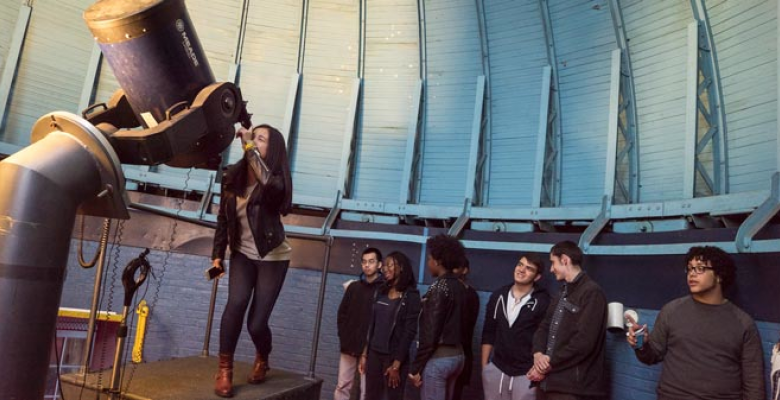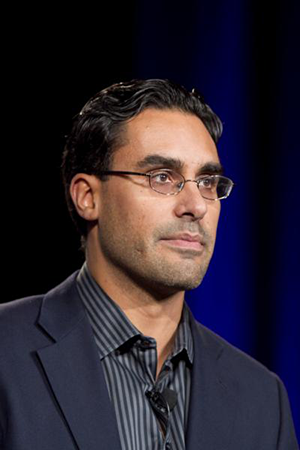Local Students and Teachers See Stars Through the Eyes of Columbia Experts


Rings of Saturn, moons of Jupiter, the constellation Cassiopeia. Young students are reaching for the stars and planets, with Columbia’s help.
Over the last seven years, Columbia graduate students have worked alongside more than a dozen high school and middle school teachers in the five boroughs and Westchester in a program called Rooftop Variables, a reference to the celestial bodies visible from local rooftops. The young people gain an opportunity to peer at the heavens with experts to guide them, and the graduate students hone their teaching skills and share their passion for science.
“Astronomy is a really easy way to get kids interested in science,” said Marcel Agüeros (CC’96), an assistant professor of astronomy at Columbia, who founded the program when he was a postdoctoral fellow here. As part of the outreach, Columbia loans 6-inch Celestron telescopes to participating schools.
“The biggest draw are the planets,” said David Deutsch, a physics teacher at Manhattan Center for Science and Mathematics in East Harlem. They are near enough for observers to see details like the rings of Saturn and not just specks of light.
Susan Clark, a Columbia graduate student in astronomy who is partnered with Curtis High School on Staten Island, said the moon elicited the most awe from her students. “It’s this familiar glowing orb they have seen their entire lives, but they gain a new appreciation for our celestial companion.”
Anthony Finney, who is principal and an astronomy teacher at the International High School for Health Sciences in Queens, said his students come to the program already intrigued with planets and outer space. “They come in with a lot of questions from things they’ve seen on television or at the movies.” He said the program offers students a hands-on experience in finding answers.
And many students want to know what it is like to be a graduate student. Alia Jackson, who teaches physics and earth sciences at Curtis High School on Staten Island, said, “The students already like astronomy. But in this program, they see someone turning it into a career.”
Studying astronomy has other educational benefits, such as learning about computer processing and imaging technology. Clark, who works with Jackson at Curtis High School, had her class train their cameras, which are attached to telescope mounts, on the Statue of Liberty one afternoon and take color images. She said, “We practiced using the telescopes and learned how to use the software that creates the images. In a separate meeting, I brought different types of lenses and we talked about the optics that make telescopes possible.”
Having a good telescope makes a difference. Omar Mahfouz, who graduated from Curtis last June, was head of the Astronomy Research Club. The school’s powerful telescope helped bring more people into the club, said Mahfouz, now a student at City College.
Sharleen Price was in the program all four years of high school at Manhattan Center for Science and Math. Now a sophomore at Barnard College, she is an astrophysics major. She said the Columbia program taught her how to assemble and use a telescope, sparked her love for observational astronomy, expanded her curiosity like no other subject and helped her make friends.
“I am very grateful that this program provided me with the necessary tools to study the sky because I know that many students in New York and across the country do not have this opportunity,” she said.
Agüeros, who continues to lead the program, became hooked on astronomy during his freshman year at Columbia after taking an introductory course in the subject. Today he researches how stars evolve over billions of years, and how their rotation rates and magnetic fields change over such an enormous span of time.
The idea for the program came to Agüeros when he began his post-doctoral fellowship at Columbia in 2006. The National Science Foundation-funded fellowship required that he spend some of his time on public outreach. He wanted to do some teacher-training, and together with astronomy graduate students and some teachers, they came up with the idea for Rooftop Variables. Agüeros submitted the idea to NASA, which provided the initial funding for the program. It has also received support from the New York Space Grant Consortium and the NSF.
Within Columbia, Agüeros also directs the Bridge to Ph.D. Program in the Natural Sciences, which helps underrepresented minorities transition into graduate programs in the sciences. The Bridge program and Rooftop Variables are based on the belief “that we can help broaden the sciences by investing in communities that are typically underexposed to research,” he said.